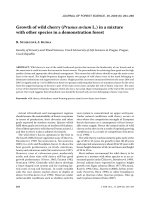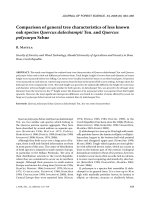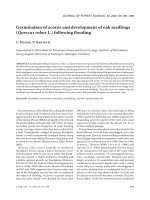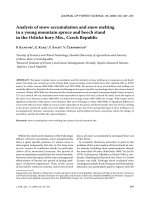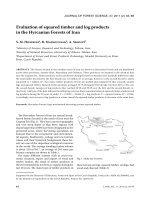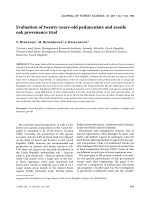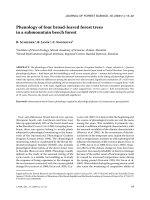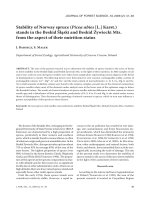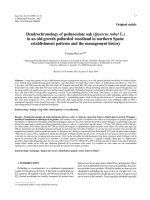Báo cáo lâm nghiệp: "Dendrochronology of pedunculate oak (Quercus robur L.) in an old-growth pollarded woodland in northern Spain: establishment patterns and the management history" ppt
Bạn đang xem bản rút gọn của tài liệu. Xem và tải ngay bản đầy đủ của tài liệu tại đây (832.38 KB, 10 trang )
13
Ann. For. Sci. 62 (2005) 13–22
© INRA, EDP Sciences, 2005
DOI: 10.1051/forest:2004091
Original article
Dendrochronology of pedunculate oak (Quercus robur L.)
in an old-growth pollarded woodland in northern Spain:
establishment patterns and the management history
Vicente ROZAS
a,b
*
a
Departamento de Biología de Organismos y Sistemas, Universidad de Oviedo, Catedrático Rodrigo Uría, 33071 Oviedo, Spain
b
Present address: Departamento de Ecología, Centro de Investigaciones Forestales y Ambientales de Lourizán,
Carretera a Marín km 4, Apartado 127, 36080 Pontevedra, Spain
(Received 13 November 2003; accepted 19 April 2004)
Abstract – Long-term patterns of tree establishment and past management practices, in an old-growth pollarded woodland in northern Spain,
were studied using dendrochronological techniques. Age distribution revealed three main cohorts of pedunculate oak (Quercus robur L.):
< 50 years, 150–200 years old, and 250–500 years old. Juveniles and trees 200–299 years were found to be clumped and spatially segregated
from older trees. Oaks older than 300 years showed a random spatial distribution. Mean pollarding intervals had increased through time, and
the mean number of suppressions per year had decreased significantly. Pollarding frequency and intensity had decreased since 1917 in mature
trees, and since 1905 in old-growths, suggesting a decline of the pollarding practice in the early 20th century. A delay of 6 years in growth
releases, with respect to growth suppressions, was common. This resulted from both strong growth recovery after pollarding, and the release of
growing space in the canopy. Mature oaks mainly showed 1–3 pollarding signals, while in old-growths between 4–7 growth suppressions per
tree were more frequent. In 1774, 1792, 1806, 1839 and 1859, small groups of trees and scattered trees were pollarded, while in 1905 a
generalised reduction of tree growth was noted. The results obtained from this study have significant connotations regarding the preservation
and management of formerly pollarded woodlands.
dendroecology / kriging / ring width / spatial pattern / tree pollarding
Résumé – Dendrochronologie du chêne pédonculé (Quercus robur L.) dans un vieux bois traité en têtard dans le nord de l’Espagne :
modèles d’installation et historique de la gestion. Des modèles à long terme d’installation des arbres et des pratiques de gestion passées ont
été étudiées en utilisant les techniques dendrochronologiques, dans un vieux bois traité en têtard du nord de l’Espagne. La distribution des âges
révèle trois principales cohortes de chênes pédonculés (Quercus robur L.) concernant l’âge des arbres : < 50 ans, 150–200 ans et 250–500 ans.
Les arbres jeunes et les arbres âgés de 200–299 ans étaient en bouquets et spatialement séparés des plus vieux arbres. Les chênes plus âgés que
300 ans montraient une distribution spatiale au hasard. La moyenne des intervalles d’étêtage s’est accrue au cours du temps et la moyenne des
suppressions annuelles a décru significativement. La fréquence de l’étêtage et son intensité ont décru depuis 1917 pour les arbres mûrs et depuis
1905 pour les vieux arbres, suggérant un déclin des pratiques d’étêtage au début du 20
e
siècle. Un retard de 6 ans dans la reprise de croissance
a été noté en relation avec la suppression des pousses. Ceci résulte ensemble du rétablissement d’une forte croissance après l’étêtage et de la
reprise de croissance dans l’espace de la couronne. Les chênes matures montrent surtout 1–3 signaux d’étêtage, tandis que 4–7 suppressions
par arbres étaient plus fréquentes chez les très vieux arbres. En 1774,1792, 1806,1839 et 1859, de petits groupes d’arbres et des arbres dispersés
étaient étêtés, tandis qu’en 1905 une réduction générale de la croissance était notée. Les résultats de cette étude ont des connotations
significatives conservant la préservation et la gestion des anciens bois traités en têtard.
dendroécologie / kriegeage / largeur des cernes / distribution spatiale / arbre traité en têtard
1. INTRODUCTION
Pollarding in wood-pastures is a traditional management
system for broad-leaved forests. It has been in widespread use
for centuries throughout Central and Western Europe [8, 38,
42]. Grazed woodlands are usually composed of ancient trees
that have grown in open spaces utilised for cattle pasture. These
areas were traditionally used as a source of pasturage, fuel, tim-
ber and other forest products. Wood for lumber or charcoal was
obtained by pollarding the tops of trees at a height of 2–3 m.
Such trees responded by producing new crops of branch-wood
out of reach of the animals. Trees regularly pollarded typically
* Corresponding author:
14 V. Rozas
developed hollow trunks with large girths, and survived for a
longer time than they would have in natural forests because of
little competition from scattered neighbours [35].
The most extensive examples of pollarded wood-pasture in
Europe are to be found in West Mediterranean woodlands.
They are composed of diverse evergreen or deciduous oak spe-
cies, which cover more than 3 million ha in the Iberian Penin-
sula [37]. The multiple agroforestry use of Mediterranean
woodlands as pasture, source of acorns, fuel and cork, along
with their partial cultivation, started in the Middle Ages. But
this use was intensified in the late 19th century and the early
20th, when many natural forests were transformed in new
wood-pastures [37]. By contrast, the area occupied by pol-
larded woodlands in the Atlantic and Central Europe have
become progressively reduced since mediaeval times as a con-
sequence of the abandonment of traditional management, the
change of land use to create farmlands and imported tree plan-
tations, or because of a natural transformation to a high forest
structure [23, 35].
Some rare small fragments of pollarded wood-pastures
remain in the Atlantic regions of Spain, usually due to their pres-
ervation in private parks, wooded commons or village greens.
These infrequent populations of veteran pollards have great
importance as havens for communities of saproxylic, epiphyte
and mycorrhizal organisms rarely found in other habitats [17,
31, 39]. For these reasons, historical management practices,
and tree life history in pollarded woodlands, should be investi-
gated in order to design efficient future conservation policies
focused on the maintenance of veteran pollards and the preserva-
tion of their special structure and ecological importance.
Dendrochronological techniques are considered to be the
most useful and accurate tools in the investigation of past regen-
eration patterns, and in the reconstruction of disturbance his-
tory in temperate forests [10, 11, 27, 33, 34]. Tree-ring analysis
has been used to reconstruct fire histories in woodlands [15,
51], to reproduce past forest insect infestations [21, 48], to
study geomorphic processes [19, 30], and to precisely date past
earthquakes [20, 46]. By contrast, dendrochronological studies,
focused on past management reconstruction in manhandled
forests, are rare [5, 9, 32]. Dendroarchaeological studies dis-
played abundant examples of pollarding signals in tree-rings [2,
3, 13, 40]. However, dendrochronological techniques have
never been used to reconstruct management systems over com-
plete pollarded woodlands.
This work is a dendrochronological reconstruction of the
management history in Tragamón, an old-growth oak wood-
land located in the Cantabrian lowlands, northern Spain. Past
regeneration patterns, and historical management systems, were
reconstructed based on tree locations and on increment cores
obtained from intensive sampling. Standard procedures of tree-
ring analysis were adapted to determine the presence of pol-
larding signals in ring-widths. Specific objectives of the study
were: (1) to investigate the temporal and spatial patterns of oak
establishment, (2) to reconstruct the temporal variation in the
frequency and intensity of growth suppressions and releases,
(3) to estimate the temporal and spatial patterns of tree pollard-
ing, and (4) to compare the reconstructed pollarding practices
among separate oak age-classes.
2. MATERIALS AND METHODS
2.1. Site description
Tragamón is located near the city of Gijón (43º 30’ N, 05º 31’ W),
on the coastal plain of Asturias, northern Spain. The soils are Haplu-
dalfs on quaternary alluvial depositions of gravel, sand, and clay, with
a geologic basement of Jurassic limestone and dolomite [14]. The cli-
mate is Atlantic, with a total annual precipitation of 980 mm, and a
mean annual temperature of 14 ºC. Tragamón is a 4.8 ha woodland
mainly composed of pedunculate oak (Quercus robur L.), and some
other native and introduced tree species, such as Acer pseudoplatanus
L., Castanea sativa Mill., Fraxinus excelsior L., Ilex aquifolium L.,
Laurus nobilis L., Prunus laurocerasus L., Quercus pubescens Willd.
and Taxus baccata L. Five C. sativa trees are also old-growth pollards
with massive, severely decomposed trunks and limbs. A road divide
the park into two parts, here named as Northern Tragamón and South-
ern Tragamón (see Fig. 3). Southern Tragamón has been used as a rec-
reation park since the 1960s, while access to Northern Tragamón was
restricted up to 1992. At the north-east of Tragamón is La Isla park,
composed of pollard and maiden pedunculate oaks. Tragamón consti-
tutes a well-preserved example of formerly pollarded wood-pasture,
a feature that has almost disappeared in the Atlantic Iberian Peninsula.
Because of the aesthetic, historical, and environmental importance of
ancient oaks, Tragamón was recently declared a Natural Monument
by the regional authorities in Asturias.
2.2. Sampling, ring-width measurement and tree-ring
dating
All living and dead trees (dbh ≥ 5 cm at 1.3 m above ground) were
identified, labelled and measured. The spatial x and y co-ordinates of
stem bases in Tragamón were measured using a GPS base station.
Twenty-five percent of the area of La Isla was also surveyed, living
and dead trees were identified, labelled and measured. The spatial co-
ordinates of trees in La Isla were not measured. All labelled adult living
oaks, without external evidence of bole rottenness, were cored with
increment borers in autumn 2000. Totals of 52 mature oaks, all of them
in La Isla, and 57 old-growth oaks, seven of them belonging to La Isla
and 50 to Tragamón, were sampled for tree-ring analysis. Old-growth
chestnut trees were not sampled because of severe bole rottenness.
Since Tragamón is a protected area, only one core per tree was taken,
100 cm above ground level, in order to minimise the damage to the
trees.
The cores were air-dried, glued onto wooden mounts and surfaced
with a series of successively finer sandpaper grits. Tree-ring series
were dated following standard procedures [47]. After preliminary dat-
ing, ring-widths were measured under magnification to the nearest
0.01 mm with a Velmex sliding-stage micrometer interfaced with a
computer. Dating and measurement errors were corrected with the pro-
gram COFECHA [18], which allowed additional, quantitative cross-
dating against a master site chronology. The master chronology was
calculated from those ring-width series correctly synchronised and
highly inter-correlated. In many cases quantitative crossdating
allowed successful dating of the complete ring-width series. However,
abrupt growth changes, found in the majority of the samples, made dat-
ing of many tree-ring series difficult, and synchronisation with the
master chronology could not be definite in some tree-ring series that
showed recurrent growth suppressions. In spite of this limitation, the
estimated accuracy of the datings of pollarding signals in particular
trees was over 2–3 years.
2.3. Tree age estimation
In cores that showed the pith, tree age was estimated as the number
of crossdated rings. In partial cores, which contained the arcs of the
Dendrochronology of oak: the management history 15
inner rings, the length of missing radii was calculated using a graphical
method based on the convergence of xylem rays at the pith [44]. The
number of missing rings was then estimated by extrapolating the radial
growth rate from the innermost five rings in the cores. In partial cores,
without the arcs of the inner rings, the length of missing radii was cal-
culated as the difference between the bole geometric radius and the
total core length. The number of missing rings was then estimated by
extrapolating the mean radial growth rate from the innermost 20 rings
in the cores [44]. Those trees that were not cored, and those from which
unusable cores had been obtained, were aged from their diameters,
using age-diameter equations calculated from cored trees. Equations
were calculated for three different oak cohorts that showed non-over-
lapping age ranges, a procedure that provided more accurate age estimates
than would have been obtained from equations based on the population
as a whole [44]. Tree-age estimates, without any correction for the time
taken to reach coring height, were summarised into age distributions
at 25-year intervals.
2.4. Spatial analysis
To study the distribution of tree ages the spatial patterns of separate
age classes were analysed using the nearest-neighbour technique [50].
Living oaks in Tragamón were arbitrarily classified into four age
classes (< 50, 200–299, 300–399 and 400–499 years) and the mean
distance between target trees and their nearest neighbours was calcu-
lated within, and between, age classes. The null hypothesis of a random
arrangement of ages among oak stems was tested using a bootstrap
procedure [28, 29]. Each previously calculated mean distance-to-the-
nearest-neighbour was compared with the mean distance expected
under the null hypothesis. The expected distance was computed from
bootstrap samples obtained by randomly distributing the ages of
neighbouring trees among tree locations, taken at random and with
replacement from the non-target trees. The significance of deviation
from the null hypothesis was calculated as the proportion of bootstrap
samples in which the expected mean distance was smaller than the
observed mean, multiplied by two to effect a two-sided test [28]. The
critical values, corresponding to the significance levels 0.05 and 0.01,
were obtained from 100 and 1000 bootstrap samples. A significant
negative deviation was interpreted as evidence of aggregation, while
a significant positive deviation indicated repulsion.
Ordination and clustering techniques are generally used to identify
even-aged patches of trees [7]. These methods focus on the establish-
ment of regions that are homogeneous with respect to tree age, but dif-
fering from spatially adjacent regions. On the other hand, kriging tech-
niques use a local estimate of the ages of neighbouring trees, corrected
to account for the global structure of age, to produce a detailed surface
map of the spatial distribution of tree ages [25]. To describe the spatial
structure of tree ages in Tragamón, a map of oak stems was plotted
along with a surface map of 100-year-age nested isolines calculated
by kriging.
2.5. Tree-ring analysis
In this work, an abrupt growth change was considered as those con-
spicuous reduction or recovery of growth within an individual tree ring
sequence [22]. Accordingly, a growth suppression was a condition of
growth retardation in a stressed tree [22]. Pollarding years appeared
anatomically as abrupt and sustained growth suppressions, in which
the earlywood width is not altered the year “0” after pollarding (Fig. 1).
However, in the years “+1” and “+2” after pollarding the widths of
the earlywood and of the whole ring are the smallest, as it has been
previously observed [2, 3]. Nevertheless, total ring-width progres-
sively increases after 3 to 4 years as a consequence of a gradual
increase in latewood width (Fig. 1). The formula for percentage
growth change, proposed by Nowacki and Abrams [33], was adapted
for the identification of abrupt and sustained growth releases and sup-
pressions. To identify growth releases this formula was used
(1)
while for suppressions it was used
(2)
where PGCr and PGCs are the percentage growth change for releases
and suppressions, respectively, and M
1
and M
2
are the preceding and
subsequent 5-year ring-width means. A 5-year period was applied to
the calculation of PGC for greater precision, even though intervals of
6 and 7 years between successive cuts have previously been discovered
on individual pollards [16, 36, 41]. Individual PGCr and PGCs chro-
nologies were calculated by applying both formulae to the individual
tree-ring series.
Based on previous criteria for the recognition of disturbance signals
in tree-rings [1, 27], two thresholds were employed to quantify the
magnitude of growth changes. A moderate release, or suppression, was
defined as a respective growth increase, or decrease, between 100 and
199%. A major release, or suppression, was defined as a respective
growth increase, or decrease, ≥ 200%. Moderate and major growth
releases and suppressions were separately compiled for mature and
old-growth oaks on an annual basis. A year with a suppression event,
indicative of tree pollarding, was considered as those in which at least
one major suppression and/or two moderate suppressions had occurred
within a ± 1 year interval. The frequency of event-occurrence was
computed as the mean number of releases and suppressions per year,
calculated in 10-year intervals lagged by one year. To identify the spa-
tial patterns of tree pollarding, stem maps of those trees that showed
growth suppressions in significant pollarding episodes were plotted.
The mean length of suppression intervals, and the mean number of sup-
pressions per tree, were calculated and compared for both mature and
old-growth oaks. Mean pollarding intervals, and the mean numbers of
suppressions per year, were calculated in 50-year periods. Actual cor-
relation between the mean frequencies of releases and suppressions,
and the maximum correlation between those lagged for up to 15 years,
were also calculated.
Figure 1. Tree-ring sequences (×10) from two oaks in Tragamón
showing growth suppressions due to pollarding (P). Arrows indicate
ring boundaries. Growth progress from right to left.
PGCr
M
2
M
1
–
M
1
-
100×=
PGCs
M
1
M
2
–
M
2
-
100×=
16 V. Rozas
3. RESULTS
3.1. Populations structure
The majority of the oaks in Tragamón were old-growth hol-
low trees larger than 60 cm in diameter and older than 250 years,
which showed descending distributions up to a maximum of
some 180 cm and 500 years (Fig. 2). In Southern Tragamón,
no trees smaller than 50 cm in diameter, and only two trees
younger than 250 years, were found. In Northern Tragamón,
however, trees smaller than 50 cm and younger than 50 years
were abundant. On the other hand, in La Isla, oaks between 40
and 80 cm in diameter and between 150 and 200 years old were
dominant. However, trees younger than 125, or older than
325 years, were not encountered (Fig. 2).
In Tragamón, oaks younger than 50 years, and those between
200–299, were significantly clumped (P < 0.01), indicating
aggregation of similarly aged trees within these age classes
(Tab. I). By contrast, mean nearest-neighbour distances between
trees older than 300 years did not significantly differ from the
distances expected under a random arrangement of tree ages.
Oaks younger than 50 years showed significant spatial repulsion
(P < 0.01) of all the other age classes, and those belonging to
the 200–299 age-class showed significant repulsion (P < 0.05)
of oaks between 400–499 years (Tab. I). All the other analyses
concerning spatial relationships between different age classes
were not statistically significant, indicating some independ-
ence among old-growth trees in Tragamón. The surface map
of oak ages showed that trees aged 200–399 years dominated
the major part of Tragamón (Fig. 3). Oaks younger than
50 years were confined to four small areas, as well as two large
ones in Northern Tragamón. Trees older than 400 years were
widely spaced throughout the park, being dominant locally in
certain parts of Southern Tragamón (Fig. 3).
3.2. Abrupt growth changes
Mean age of the sampled mature oaks was 182 years, while
for old-growth oaks it was 306 years, and their age ranges did
not overlap (Tab. II). The percentage of moderate releases was
greater than the percentage of major releases in mature as well
as old-growth oaks, while the percentage of major suppressions
was greater than the percentage of moderate suppressions overall.
The number of pollarding events identified in old-growth
oaks was greater than in mature oaks (Tab. II, Figs. 4 and 5).
In mature oaks, the period with the greatest frequency of sup-
pressions was 1825–1900, and the years that showed the great-
est number of growth suppressions were 1839, 1845, 1849,
Table I. Mean distances (m) between target trees and their nearest neighbours belonging to equal or different age class, and deviations (Dev.)
from mean distances expected under the hypothesis of random arrangement of ages among oak stems. A significant negative deviation indica-
tes aggregation of similarly aged trees, and a significant positive deviation indicates segregation between differently aged trees. N: number of
target trees.
Age class (yr) N
< 50 200–299 300–399 400–499
Mean Dev. Mean Dev. Mean Dev. Mean Dev.
< 50 56 5.9 –7.9**
200–299 74 39.0 25.3** 9.3 –2.7**
300–399 80 37.2 23.5** 13.9 2.0 11.4 –0.1
400–499 22 38.8 25.1** 20.6 8.7* 12.6 1.1 25.1 2.2
* P < 0.05; ** P < 0.01.
Figure 2. Diameter distribution, in 10-cm classes, and age distribu-
tion, in 25-year classes, of oak trees found in Southern Tragamón
(ST), Northern Tragamón (NT) and La Isla (LI).
Dendrochronology of oak: the management history 17
1851, 1861 and 1917 (Fig. 4). Mean pollarding intervals for
mature oaks ranged from 5.4 years in the period 1850–1899 to
68 years in 1950–2000, and the mean number of suppressions
per year decreased through time, being significantly greater in
the 19th century than in the 20th (H = 63.13, DF = 3, P < 0.001,
Kruskal-Wallis test; Tab. III). In old-growth oaks, the period
with the most frequent suppressions was 1750–1925, with the
years 1756, 1774, 1806, 1839, 1859 and 1905 showing a large
number of growth suppressions (Fig. 5). Twenty-seven old-
growth oaks showed growth suppression in 1905, which rep-
resent 52.9% of the sample size for this year. Mean pollarding
intervals in old-growth oaks increased through time from
4.4 years in 1750–1799 to 11.5 years in 1950–2000, while the
mean number of suppressions per year significantly decreased,
being over 1.50 in the period 1750–1849, around 1.00 in 1850–
1949, and 0.32 in 1950–2000 (H = 108.14, DF = 4, P < 0.001;
Tab. III).
Peaks in the number of releases per year roughly coincided
with peaks in the number of suppressions, although the formers
were delayed by several years (Figs. 4 and 5). This delay
became more evident when the mean numbers of releases and
suppressions per year were plotted together (Fig. 6). Taking the
complete period of analysis as a whole a maximum correlation
between the frequency of suppressions and releases, when the
Table II. Number of trees sampled, age data, periods and characteristics of the tree-rings measured in Tragamón for mature and old-growth
oaks.
Mature Old-growth
Number of sample trees 52 57
Mean age ± SD (years) 182 ± 11 306 ± 54
Age range (years) 138–206 225–471
Period of record 1775–2000 1664–2000
Period of analysis 1800–2000 1725–2000
Number of measured rings 8236 12299
Rings with a moderate release (%) 0.83 1.59
Rings with a major release (%) 0.24 0.48
Rings with a moderate suppression (%) 0.59 1.14
Rings with a major suppression (%) 0.75 1.26
Number of pollarding events in the period of analysis 17 47
Figure 3. Surface map of Tragamón showing the location of oak
stems and 100-year-age nested isolines. Symbols represent trees of
different age: dots < 120 years, diamonds = 200–299 years, squares =
300–399 years, triangles = 400–499 years.
Figure 4. Number of mature oaks with moderate and major growth
releases and suppressions, and the size of sample cores. Triangles
represent years with at least one major suppression and/or two mode-
rate suppressions within a ±1 year interval.
18 V. Rozas
frequency of releases was delayed by 6 years, was obtained (R =
0.899, N = 216, P < 0.001 in mature oaks, R = 0.768, N = 276,
P < 0.001 in old-growth oaks). This correlation was shown to
be greater than that calculated without any delay (R = 0.749 in
mature oaks, R = 0.315 in old-growth oaks). In fact, the delay
with the maximum positive correlation varied among periods,
Table III. Mean pollarding intervals, mean number of suppressions per year and correlation between the frequencies of releases and suppres-
sions in successive 50-year periods, for mature and old-growth oaks. Different letters in a row indicate significant differences according to a
Kruskal-Wallis test at P = 0.05.
1750–1799 1800–1849 1850–1899 1900–1949 1950–2000
Mature
MPI (years) 8.6 5.4 19.0 68.0
Suppressions per year 0.97a 0.80a 0.23b 0.18b
Actual R 0.928*** 0.836*** –0.032 0.195
Delay with maximum R 65100
Maximum R 0.979*** 0.873*** 0.747*** 0.195
Old-growth
MPI (years) 4.4 4.9 5.1 6.1 11.5
Suppressions per year 1.50a 1.66a 1.00b 0.98b 0.32c
Actual R –0.397** –0.572*** 0.309* 0.148 –0.179
Delay with maximum R 656710
Maximum R 0.722*** 0.229 0.926*** 0.902*** 0.379**
* P < 0.05; ** P < 0.01; *** P < 0.001.
Figure 5. Number of old-growth oaks with moderate and major growth releases and suppressions, and the size of sample cores. Triangles repre-
sent years with at least one major suppression and/or two moderate suppressions within a ±1 year interval.
Dendrochronology of oak: the management history 19
ranging from between 5 to 10 years, with a greater frequency
of 6 and 5 years in the period 1750–1899, and of 10 years in
the 20th century (Tab. III).
The patterns of spatial distribution of old-growth oaks,
which showed synchronic growth suppressions, differed for
separate pollarding episodes (Fig. 7). Spatial dispersion of oaks
pollarded in the years 1774 and 1792 showed similar patterns,
as found in a specific group of trees in Northern Tragamón, as
well as separate trees in Southern and Northern Tragamón. Oak
pollarding in 1806 affected the southernmost extreme of South-
ern Tragamón, and the north-central area of Northern Trag-
amón. On the other hand, oaks pollarded in 1839 and 1859
showed similar distributions, particularly on the east border of
Southern Tragamón and the north-east border of Northern
Tragamón. Finally, the episode of massive growth reduction
which occurred in 1905 affected trees more or less distanced
throughout the complete range of old-growth oaks in Tragamón.
The length of suppression-intervals showed wide disper-
sion, with maximum lengths of up to 165 and 135 years in
mature and old-growth oaks (Fig. 8). Intervals of 10–20 years
between successive suppressions were more frequent in mature
oaks, and in old-growth oaks intervals of 10–30 years predom-
inated. However, the mean length of suppression intervals did
not significantly differ between age classes (mean ± SD = 40.1 ±
39.6 years in mature oaks, 28.1 ± 19.9 years in old-growth oaks,
U
60,239
= 7153.0, P = 0.977, Mann-Whitney test). By contrast,
the mean number of suppressions per tree was significantly
greater in old-growth oaks (mean ± SD = 2.1 ± 1.0 in mature
oaks, 5.2 ± 2.4 in old-growth oaks, U
52,57
= 431.0, P < 0.001).
Plots of frequency distribution indicated that mature oaks
mainly showed between 1 and 3 suppressions, while in old-
growths between 4 and 7 growth suppressions per tree were
more frequent, with maximums of up to 5 and 10 suppressions
in mature and old-growth oaks (Fig. 8).
Figure 6. Temporal variation in the mean number of suppressions
and releases per year, calculated in 10-year intervals, for mature and
old-growth oaks.
Figure 7. Spatial dispersion of old-growth oaks in Tragamón that
showed synchronic abrupt growth suppressions in six relevant pol-
larding episodes.
Figure 8. Percent frequency of the length of intervals between suc-
cessive suppressions, and the number of suppressions per tree, in
mature and old-growth oaks. N: number of suppression intervals and
trees analysed.
20 V. Rozas
4. DISCUSSION
4.1. Limitations of the results
The results obtained should be interpreted with some caution
due to certain accepted limitations in the materials studied and
the analytical procedures used. Mean absolute errors, associated
with the methods used to age young and mature oaks, can extend
from 5 to 27 years [44]. What is more, errors in age estimates when
these methods are applied to old-growth trees are unknown, as
they have never been tested on oaks older than 300 years. It can
be supposed that their accuracy probably decreased when bole
diameter and tree age increased. In this particular study, accu-
rate age estimation and past management reconstruction have
been difficult to determine, since the majority of the trees in
Tragamón showed some degree of bole decay. The loss of many
radial growth sequences, through wood decay, prevented more
accurate age estimation in old-growth trees, and probably
reduced the signals of pollarding events.
However, the used method for management history recon-
struction could tend to overestimate pollarding episodes, as all
growth suppressions could not be a consequence of tree pol-
larding. Insect outbreaks that cause defoliation (e.g. Lymantria
dispar L., Tortrix viridiana L. and Altica quercetorum Foundr.)
or other defoliating outbreaks (oak mildew, Microsphaera
alphitoides Griff. & Maubl.) are very frequent in oaks and can
lead to growth reductions similar to those caused by pollarding.
Thus, the frequencies and intensities of pollarding episodes, as
reconstructed in this work, might not exactly correspond to
actual events. However, most of the growth suppressions were
attributed to pollarding, as they showed an anatomical appear-
ance typical of pollarding signals (Fig. 1) [2, 3]. The systematic
coring of all trees without external evidence of bole decay, and
the combination of moderate and strict criterions for event iden-
tification, should guarantee that the obtained reconstruction is
largely reliable, as have other methods normally used to recon-
struct disturbance regimes in temperate forests [1, 11, 27, 33,
43, 45].
4.2. Establishment patterns
Size and age distribution indicated a lack of oak regeneration
in Southern Tragamón, while in Northern Tragamón trees
younger than 50 years were abundant, indicating an hiatus in
tree recruitment between 50 and 200 years ago. On the other
hand, age distribution in La Isla was typically even-aged, with
the majority of the trees being between 150–200 years old.
These kinds of population structures are a consequence of alter-
nating periods of light and heavy grazing pressure, in which
seedlings may, or may not, have been established [17, 37]. Over
the past 50 years, oaks in Northern Tragamón have shown a
regeneration pattern typical of this species. Pedunculate oak is
a gap-obligate species that regenerates in open spaces and can-
opy gaps [45]. Accordingly, juvenile oaks were established
away from old-growth trees in four gaps and in two large open
areas (Fig. 3). Moreover, juveniles of oak and other minor
woody species, such as Cornus sanguinea L., Euonymus euro-
paeus L. and Salix atrocinerea Brot., were associated with pop-
ulations of Rubus spp., Smilax aspera L. and Ulex gallii Planch.
These spiny species, along with the heathers Erica vagans L.
and Daboecia cantabrica (Huds.) C. Koch, could have played
the role of nurse-plants which encouraged oak regeneration by
protecting seedlings and young shoots from herbivore damage,
such as grazing and trampling, as has been confirmed for other
oak species [4, 12], and also for pedunculate oak [24]. The
absence of any recent regeneration in Southern Tragamón
could be interpreted as a lack of safe sites appropriate for oak
establishment, this being the result of past over-grazing and,
more recently, of lawn maintenance labour and trampling by
the public.
The spatial structure of tree ages is an indicator of whether
tree establishment has occurred either randomly or in even-
aged patches. In the former pattern, neighbouring individuals
will not necessarily be of a similar age, while in the latter strong
similarities between the ages of neighbouring trees is to be
expected [7, 28]. In Tragamón, oak recruitment occurred in
even-aged clumps, spatially segregated from adult trees. This
pattern was evident in trees younger than 50 years, and also in
trees in the 200–299 year class which displayed a clumped pat-
tern and a spatial segregation from veteran oaks, those older
than 400 years (Tab. I). This result suggests that a former can-
opy of adult trees could have influenced the establishment of
trees aged between 200–299 years. However, this pattern does
not correspond with the normal distribution of mature trees in
a natural forest because density-dependent mortality generally
produces a transformation of the initial clumped pattern into
either a random or regular distribution [49]. A consequence of
tree pollarding is a prolongation of the life span. This is because
the restriction of crown development delays the stage at which
the demand for water and nutrients begins to outstrip the ability
of trees to increase their absorptive root area [26]. In both
Southern and Northern Tragamón, prolonged lifetimes in pol-
larded trees can explain the preservation of the initial clumped
pattern in those oaks belonging to the 200–299 age class. In cer-
tain sectors of both areas, oaks between 200–399 years proved
to be roughly aligned, suggesting that several groups of trees
could have been planted. On the other hand, a random pattern
should be expected for old-growth oaks due to the cumulative
effects of recurrent pollarding and to the effect of ageing on tree
survival [6, 41]. This expectation was confirmed in this work
for trees older than 300 years, but the sparse spatial distribution
exhibited by such trees prevented any more substantial conclu-
sions, relative to establishment patterns, from being reached.
4.3. Evidence of management history
Old-growth trees showed more growth suppressions and
were more frequently pollarded than mature trees. Examination
of pollarding signals compiled for Tragamón and La Isla
(Figs. 4 and 5) revealed that several dates of growth suppres-
sion coincided in many oaks, independent of their ages. This
happened in 1806, 1832–1833, 1839, 1844–1845, 1851, 1853–
1854, 1866–1867, 1881–1882, 1898, 1917–1918 and 1984–
1985, in which suppressions were found on mature and old-
growth trees. However, many pollarding signals were only
found in old-growth oaks, especially those registered prior to
1800, in which the mature trees were not pollarded yet. The spa-
tial distribution of pollarding signals found in ring-widths
revealed that particular patterns of tree selection can be iden-
tified in successive cutting turns (Fig. 7). Small groups of trees,
Dendrochronology of oak: the management history 21
along with several scattered trees, were pollarded in each turn,
with the exception of 1905, in which a generalised reduction
of growth was detected. This procedure is not as typical as that
previously described in certain historical documents, in which
woodland sections were pollarded in succession, following a
regular cycle [6]. Probably, many trees to be pollarded in each
cutting turn were selected by following a previously established
scheme, but many of them, even the majority, could have been
selected to maximise the amount of useable branch-wood, inde-
pendent of the time that had elapsed since their last cut.
Many mature oaks in La Isla showed only one, two or three
pollarding signals, while the majority of old-growth oaks found
in Tragamón and La Isla showed between four to seven (Fig. 8).
This could be because of the shorter life-span of mature trees,
but it could also be a consequence of the different ownership
of Tragamón and La Isla up to recent times, which determined
different management systems for old-growth and mature trees.
The majority of the sampled old-growths were found in Trag-
amón, which was a public common over past centuries and up
to the 1990s. By contrast, all the mature trees were found in La
Isla, an area which was acquired by a private landowner in the
19th century, and since that time has not been as intensively
exploited as Tragamón. Probably, many mature trees in La Isla
were shredded or trimmed instead of pollarded, as deduced by
its aspect of maiden trees [38]. However, in mature as well as
old-growth oaks, the mean pollarding interval consistently
increased over time, and the mean number of suppressions per
year decreased, both of which indicate a change in management
system. Frequency and intensity of suppressions has decreased,
particularly since 1917 in mature trees, and since 1905 in old-
growths (Figs. 4 and 5). The loss of the pollarding practice,
especially during the 20th century, could cause the collapse of
many old-growth pollards, because of the accumulation of
weight on severely decomposed trunks [41].
According to the findings obtained in this study, a delay of
growth releases with respect to growth suppressions was evi-
dent (Fig. 6 and Tab. III). This delay was of 5–6 years prior to
1900, in which both mature and old-growth oaks were actively
managed, but varied from 0 to 10 years in the 20th century, as
a consequence of a modification in the practice of pollarding.
The growth releases which showed a characteristic delay of 5–
6 years were of two different types: releases that resulted from
growth recovery after pollarding in the same tree, and releases
that were a consequence of growing space being released in the
canopy when neighbouring trees were pollarded. Both types
occurred principally prior to 1900. By contrast, from 1900
onwards, releases unrelated to growth-suppressions, which were
a consequence of growing space released when neighbouring
trees died, were also discovered. In these latter cases, any delay
that might be expected as a response of tree growth to the
release of growing space, fluctuated according to a combina-
tion of separate factors (tree age and canopy position, health sta-
tus of the tree, competition for resources, climatic restrictions,
disturbances, and chance [27, 33]). Overall, very little compar-
ative information on past management practices in pollarded
woodlands was available, other than the sporadic dating of pol-
larding signals based on tree-ring counting in single trees [6,
36, 41]. Also, no documentary evidence that supplemented the
reconstructed management history in Tragamón was found.
However, this work constitutes an innovative approach, which
demonstrates the usefulness of dendroecological techniques in
reconstructing past establishment patterns and historical man-
agement practices in old-growth pollarded woodlands.
5. CONCLUSION
There is vast potential for obtaining the history of long-term
management systems through radial-growth analysis in many
pollarded woodlands in Europe, which represent our best mate-
rial to gain knowledge about traditional management practices.
However, this availability may be particularly short-lived for
old-growth pollards, which are continuously succumbing for a
variety of reasons [23, 41]. Many threats, which are in common
with other European pollarded woodlands, were discovered in
Tragamón. Because of the uncertainty of their future, the study
of existing old-growth pollarded woodlands should be among
the highest priorities for researchers in dendrochronology.
Nonetheless, the coupled study of oak establishment dates and
tree-ring widths revealed that historical patterns of tree regen-
eration and woodland management can be reasonably repro-
duced. The approach used in this study represents a significant
contribution in the field of dendroecology, and should have
broad application to a wide range of pollarded woodland types.
They let us not forget that the documentation of past manage-
ment systems is paramount in the understanding of how
present-day pollarded woodlands developed over recent histo-
ries, and how they might alter in the future.
Acknowledgements: The author thanks Juan Luis Menéndez and
Francisco Javier Suárez for field assistance, Juan Carlos Martínez for
providing useful information on the recent history of Tragamón, and
Kenneth McKenney for correcting the English manuscript. The Ayunta-
miento de Gijón and the Dirección General de Recursos Naturales y
Protección Ambiental del Principado de Asturias gave permission for
taking the cores. This research was supported by the Consejería de
Medio Ambiente del Principado de Asturias (SV-PA-00-01).
REFERENCES
[1] Abrams M.D., Orwig D.A., DeMeo T.E., Dendroecological analy-
sis of successional dynamics for a presettlement-origin white-pine–
mixed-oak forest in the southern Appalachians, USA, J. Ecol. 83
(1995) 123–133.
[2] Bernard V., Autour du moulin carolingien de Belle-Église (Oise):
éléments de techniques de charpenterie hydraulique, in: Beck P.
(Ed.), Actes du VI
e
Congrès International d’Archéologie Médié-
vale: L’innovation technique au Moyen âge, Errance, Paris, 1997,
pp. 77–80.
[3] Bernard V., Renaudin S., Marguerie D., Evidence of trimmed oaks
(Quercus sp.) in north western France during the early Middle Ages
(9th–11th century A.D.), in: 6th International Conference on Den-
drochronology, Quebec, 2002, pp. 15–17.
[4] Callaway R.M., Effect of shrubs on recruitment of Quercus dougla-
sii and Quercus lobata in California, Ecology 73 (1992) 2118–
2128.
[5] Cherubini P., Piussi P, Schweingruber F.H., Spatiotemporal growth
dynamics and disturbances in a subalpine spruce forest in the Alps:
a dendroecological reconstruction, Can. J. For. Res. 26 (1996) 991–
1001.
[6] Dagley J., Burman P., The management of the pollards of Epping
Forest: its history and revival, in: Read H.J. (Ed.), Pollard and vete-
22 V. Rozas
ran tree management, II, Corporation of London, Burnham Beeches,
1996, pp. 29–41.
[7] Duncan R.P., Stewart G.H., The temporal and spatial analysis of
tree age distributions, Can. J. For. Res. 21 (1991) 1703–1710.
[8] Ellenberg H., Vegetation ecology of Central Europe, Cambridge
University Press, Cambridge, 1988.
[9] Freléchoux F., Buttler A., Gillet F., Gobat J M., Schweingruber
F.H., Succession from bog pine (Pinus uncinata var. rotundata) to
Norway spruce (Picea abies) stands in relation to anthropic factors
in Les Saignolis bog, Jura Mountains, Switzerland, Ann. For. Sci.
60 (2003) 1–10.
[10] Fritts H.C., Swetnam T.W., Dendroecology: a tool for evaluating
variations in past and present forest environments, Adv. Ecol. Res.
19 (1989) 111–188.
[11] Glitzenstein J.S., Harcombe P.A., Streng D.R., Disturbance, suc-
cession, and maintenance of species diversity in an east Texas
forest, Ecol. Monogr. 56 (1986) 243–258.
[12] Gómez J.M., García D., Zamora R., Impact of vertebrate acorn- and
seedling-predators on a Mediterranean Quercus pyrenaica forest,
For. Ecol. Manage. 180 (2003) 125–134.
[13] Guibal F., Bernard V., Approche dendrochronologique de l’évolu-
tion récente du système bocager armoricain, in: Richard H., Vignot
A. (Eds.), Équilibres et ruptures dans les écosystèmes durant les
20 derniers millénaires: durabilité et mutation, Presses Universitai-
res Franc-Comtoises, Besançon, 2002, pp. 463–471.
[14] Guitián F., Muñoz M., Carballas T., Alberto F., Suelos Naturales de
Asturias, CSIC, Instituto de Investigaciones Agrobiológicas de
Galicia, Santiago de Compostela, 1985.
[15] Guyette R.P., Spetich M.A., Fire history of oak–pine forests in the
Lower Boston Mountains, Arkansas, USA, For. Ecol. Manage. 180
(2003) 463–474.
[16] Haas J N., Schweingruber F.H., Wood anatomical evidence of pol-
larding in ash stems from the Valais, Switzerland, Dendrochrono-
logia 11 (1994) 35–43.
[17] Harding P.T., Wall T. (Eds.), Moccas: an English deer park, Centre
for Ecology and Hydrology, English Nature, Peterborough, 2000.
[18] Holmes R.L., Computer-assisted quality control in tree-ring dating
and measurement, Tree-Ring Bull. 43 (1983) 69–78.
[19] Hupp C.R., Simon A., Bank accretion and the development of vege-
tated depositional surfaces along modified alluvial channels, Geo-
morphology 4 (1991) 111–124.
[20] Jacoby G.C., Application of tree ring analysis to paleoseismology,
Rev. Geophys. 35 (1997) 109–124.
[21] Jardon Y., Filion L., Cloutier C., Tree-ring evidence for endemicity
of the larch sawfly in North America, Can. J. For. Res. 24 (1994)
742–747.
[22] Kaennel M., Schweingruber F.H., Multilingual glossary of dendro-
chronology: terms and definitions in English, German, French,
Spanish, Italian, Portuguese, and Russian, Swiss Federal Institute
for Forest, Snow and Landscape Research, Haupt, 1995.
[23] Kirby K.J., Thomas R.C., Key R.S., McLean I.F.G., Hodgetts N.,
Pasture-woodland and its conservation in Britain, Biol. J. Linn.
Soc. 56 (1995) 135–153.
[24] Kuiters A.T., Slim P.A., Tree colonisation of abandoned arable
land after 27 years of horse-grazing: the role of bramble as a facili-
tator of oak wood regeneration, For. Ecol. Manage. 181 (2003)
239–251.
[25] Legendre P., Fortin M J., Spatial pattern and ecological analysis,
Vegetatio 80 (1989) 107–138.
[26] Lonsdale D., Pollarding success or failure: some principles to consider,
in: Read H.J. (Ed.), Pollard and Veteran Tree Management II, Cor-
poration of London, Burnham Beeches, 1996, pp. 100–104.
[27] Lorimer C.G., Frelich L.E., A methodology for estimating canopy
disturbance frequency and intensity in dense temperate forests,
Can. J. For. Res. 19 (1989) 651–663.
[28] Lusk C.H., Smith B., Life history differences and tree species
coexistence in an old-growth New Zealand rain forest, Ecology 79
(1998) 795–806.
[29] Manly B.F.J., Randomization, Bootstrap and Monte Carlo,
Methods in Biology, Chapman & Hall, London, 1997.
[30] Marin P., Filion L., Recent dynamics of subarctic dunes as determi-
ned by tree-ring analysis of white spruce, Hudson Bay, Québec,
Quat. Res. 38 (1992) 316–330.
[31] Moe B., Botnen A., A quantitative study of the epiphytic vegetation
on pollarded trunks of Fraxinus excelsior at Havrå, Osterøy, wes-
tern Norway, Plant Ecol. 129 (1997) 157–177.
[32] Motta R., Garbarino F., Stand history and its consequences for the
present and future dynamic in two silver fir (Abies alba Mill.)
stands in the high Pesio Valley (Piedmont, Italy), Ann. For. Sci. 60
(2003) 361–370.
[33] Nowacki G.J., Abrams M.D., Radial-growth averaging criteria for
reconstructing disturbance histories from presettlement-origin
oaks, Ecol. Monogr. 67 (1997) 225–249.
[34] Payette S., Filion L., Delwaide A., Disturbance regime of a cold
temperate forest as deduced from tree-ring patterns: The Tantaré
ecological reserve, Quebec, Can. J. For. Res. 20 (1990) 1228–1241.
[35] Peterken G.F., Natural Woodland: Ecology and Conservation in
Northern Temperate Regions, Cambridge University Press, Cam-
bridge, 1996.
[36] Pilcher J.R., Dendrochronological insights into past oak growth,
Ann. Sci. For. 53 (1996) 663–670.
[37] Pulido F.J., Díaz M., Hidalgo de Trucios S.J., Size structure and
regeneration of Spanish holm oak Quercus ilex forests and dehesas:
effects of agroforestry use on their long-term sustainability, For.
Ecol. Manage. 146 (2001) 1–13.
[38] Rackam O., Ancient woodland: its history, vegetation and uses in
England, E. Arnold, London, 1980.
[39] Ranius T., Influence of stand size and quality of tree hollows on
saproxylic beetles in Sweden, Biol. Conserv. 103 (2002) 85–91.
[40] Rasmussen P., Pollarding of trees in the Neolithic: often presumed
– difficult to prove, in: Robinson D.E. (Ed.), Experimentation and
Reconstruction in Environmental Archaeology, Oxbow Books,
Roskilde, 1990, pp. 77–98.
[41] Read H., Veteran trees: a guide to good management, English
Nature, The Countryside Agency and English Heritage, Peterbo-
rough, 2000.
[42] Rodwell J.S. (Ed.), British plant communities, Volume 1: Woo-
dlands and scrub, Cambridge University Press, Cambridge, 1991.
[43] Rozas V., Detecting the impact of climate and disturbances on tree-
rings of Fagus sylvatica L. and Quercus robur L. in a lowland forest in
Cantabria, Northern Spain, Ann. For. Sci. 58 (2001) 237–251.
[44] Rozas V., Tree age estimates in Fagus sylvatica and Quercus
robur: testing previous and improved methods, Plant Ecol. 167
(2003) 193–212.
[45] Rozas V., Regeneration patterns, dendroecology, and forest-use
history in an old-growth beech–oak lowland forest in Northern
Spain, For. Ecol. Manage. 182 (2003) 175–194.
[46] Stahle D.W., VanArsdale R.B., Cleaveland M.K., Tectonic signal
in baldcypress trees at Reelfoot Lake, Tennessee, Seism. Res. Lett.
63 (1992) 439–447.
[47] Stokes M.A., Smiley T.L., An introduction to tree-ring dating, Uni-
versity of Chicago Press, Chicago, 1968.
[48] Swetnam T.W., Lynch A.M., Multicentury, regional-scale patterns
of western spruce budworm outbreaks, Ecol. Monogr. 63 (1993)
399–424.
[49] Szwagrzyk J., Czerwczak M., Spatial patterns of trees in natural
forests of East-Central Europe, J. Veg. Sci. 4 (1993) 469–476.
[50] Upton G.J.G., Fingleton B., Spatial data analysis by example,
Volume I. Point pattern and quantitative data, Wiley & Sons, Chi-
chester, 1985.
[51] Veblen T.T., Kitzberger T., Villalba R., Donnegan J., Fire history
in Northern Patagonia: the roles of humans and climatic variation,
Ecol. Monogr. 69 (1999) 47–67.
